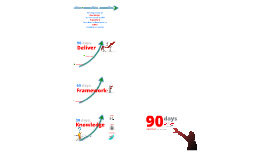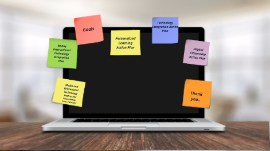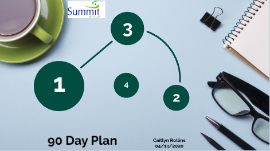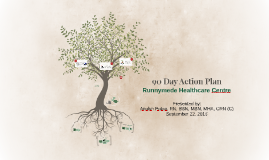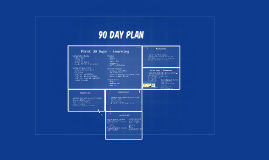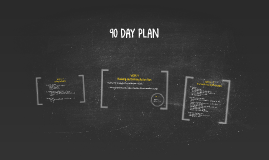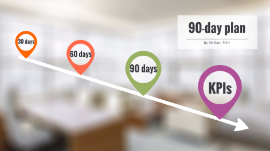90 Day Plan
Transcript: Media and Educational Technology Instructor Presented by: Lisa Lewis Ed.S Media and Educational Technology Instructor 90 Day Instructional Technology Integration Plan Presented by: Lisa Lewis Ed.S 90 Day Instructional Technology Integration Plan The purpose of this plan is to establish a timeline that enables teachers to implement an effective strategy for facilitating content that students need to learn and how they should learn it. The action steps to achieve these goals will happen in three steps: Personalized Learning, Technology Integration and Digital Citizenship. 90 Day Instructional Technology Integration Plan Goals Provide instruction that is differentiated and paced to the needs of the student and tailored to their individual learning preferences and interests. Goal 1 Personalized Learning Provide the use of available technology to deliver instructional content. The use to technology will allow students to work based on their academic ability and become independent life-long learners. Goal 2 Technology Integration To provide and understand the safe practice and ethical/social use of instructional technology. Goal 3 Digital Citizenship Personalized Learning Action Plan Create a Learner Profile Personalized Learning Action Plan Student self assessment: have students assess their own strengths and weaknesses. Teachers can can create a survey for students to assess interests and strengths. Google docs Survey Monkey https://docs.google.com/forms/d/e/1FAIpQLSewTH_KvGShH7Zfmr3wakaSDFoA2jqb42oWwK8K7sysIEGeUg/viewform https://www.surveymonkey.com/r/?sm=XsDSoPLKu3njFAsVzIfqFxEPp_2Fc2pM9ILT5ngnHGYBg_3D Personalized Learning Action Plan Student choose activities and exercises to demonstrate mastery of content standard. Provide self-assessments that students can take on their own. Provide them with one or two quizzes or simulations that enable them to test their own progress and knowledge comprehension. Each activity gives them a better understanding of the topic so assessments are based off of proficiency , which gives teacher the opportunity to pinpoint the individual’s learning style and needs. Create Learner-Specific Goals Personalized Learning Action Plan This video is about the seven principles of personalized learning being implemented in Georgia's Fulton County School System. Personalized Learning Students work at their own pace by mastering clearly-defined goals that are continually assessed. A student is graded and advances as soon as they demonstrates mastery. Use of platforms like Reading Plus, Khan Academy, Moby Max, Carnegie Math, iReady, Accelerated Math, Star Math, Phoenix etc. will allows students the chance to check their progress along the way and ensure that they are on the proper path. As well as provide direction and feedback. Student-teacher conference Competency Based Progression Personalized Learning Action Plan http://www.fultonschools.org/en/divisions/acd/learnteach/Learning%20and%20Teaching/iReady.pdf https://www.khanacademy.org/signup?isteacher=1 Technology Integration Action Plan Teachers will use technology to provide instruction that is rigorous, relevant and facilitates student learning at their own pace. Technology Integration Action Plan Develop self/paced/flipped classroom model of teaching and learning using digital learning activities: Use dashboard (FCS Launchpad/Classlinks, Fulton Virtual) to communicate and collaborate with students, parents and teachers. Share course syllabus and class information Use cloud-based tools (and Office 365) with students to participate and complete multimedia presentations in all content areas using technology communications. Students will receive instruction addressing technology skills while integrating those skills in Math, ELA, Science and Social Studies. Technology Integration Action Plan Students will receive online and classroom instruction covering the fundamentals of computer applications and understand their proper use and productivity. Students will use technology platforms and resources to improve math and reading skills. Students will be evaluated by online assessments and teacher observation to determine proficiency levels. Students will use technology both individually and collaboratively to organize and develop creative solutions, ideas or products. Students will use technology to collect, analyze, make connections and present information. Technology Integration Action Plan Students will use online collaborations, digital platforms and appropriate online resources to research content related information Digital Citizenship Action Plan Students will understand and practice safe and ethical use of instructional technology. Digital Citizenship Action Plan Students must sign and abide by the Acceptable Use Policy. Students will utilize the Common Sense K-12 Digital Citizenship Curriculum to learn about safe, responsible and ethical internet safety. Students will receive online training addressing “digital citizenship” and Students






